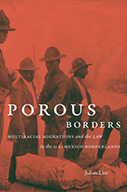Porous Borders: Multiracial Migrations And The Law In The U.S.-Mexico Borderlands

Author: Julian Lim
Publisher: Chapel Hill, NC: University of North Carolina Press, 2017. 320p.
Reviewer: Matthew Ward | May 2018
In Porous Borders: Multiracial Migrations and the Law in the U.S.-Mexico Borderlands, historian Julian Lim reconstructs long erased histories of the U.S. and Mexico’s late-nineteenth century multi-racial and ethnic borderlands. Tracing the everyday struggles, resistance, and success among African-American, Chinese, Mexican, Indigenous, Anglo-American and European border crossers, Lim illuminates the murky, contested processes of constructing “social, political, and legal notions of race and belonging in both countries” (198).
Bridging late-nineteenth century Native American, U.S., and Mexican immigration histories, chapter one documents the inextricable connection between capitalism’s Westward expansion, the opening of the borderlands to new immigrant populations, and the closing of the border to indigenous populations. Of particular note in this chapter is Lim’s implication of Asian, Black, and Mexican immigrants in the erasure of indigenous populations along the borderlands, and the revelation that the modern multi-racial and ethnic borderlands were built on the rubble of indigenous societies.
Chapter two delves into the private and public spaces of late-nineteenth century El Paso, “a unique space…where ethnoracial boundaries… [were often] blurred and left porous” (93). Progressive as it was, however, El Paso was also ground zero for the erasure of multi-raciality throughout the borderlands. Cloaked in white supremacist ideology, El Paso’s elites and social reformers introduced mechanisms for policing the populace and purging the city of multi-racial undesirables. Their success then laid the groundwork for an emerging American immigration system colored by notions of racial purity that would help cement segregation as a defining characteristic of America’s national identity.
Chapters 3 and 4 trace the social marginalization and criminalization Chinese immigrants, in particular, experienced in the borderlands, while also recalling the diverse ways they manipulated immigration policy and U.S. border officials to their advantage. Most importantly in these chapters, Lim takes the reader on a journey into the spaces between official policy and on-the-ground policy implementation, revealing the social processes through which seemingly fixed racial categories were constructed and ethno-racial identities included and excluded from ‘the nation.’
The fifth and final chapter discusses how the U.S. and Mexican immigration systems, both undergirded by a racial-exclusionary logic—developed along parallel tracks in the early 20th century, resulting in national identity projects that yielded increasingly homogenous populations. However, some of the most profound insights Lim offers are presented in an all- too-brief ‘Epilogue’ discussing her work’s connection to more contemporary moments. Here, Lim warns about the negative consequences of “historical amnesia” (200), cogently observing that the “adulation that accompanies much of today’s discussions about mixed-race Americans threatens to collapse multiracialism with postracialism and confuse racial mixing with racial harmony” (199). Multiracialism should not be romanticized, for—as Lim clearly demonstrates throughout her book—it has grown up alongside and been used to “support evolving systems of racial oppression and domination” (199). This framing in mind, Lim’s history of multiracial migration in the U.S.-Mexico borderlands isn’t just a well-executed piece of academic scholarship. In addition, it is also a clear warning regarding the dangers of naively embracing multiracialism as a panacea for America’s contemporary racial woes.
Matthew Ward, Assistant Professor of Sociology, The University of Southern Mississippi


